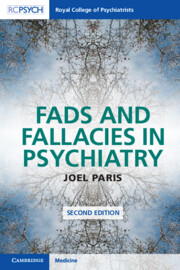Book contents
- Fads and Fallacies in Psychiatry
- Fads and Fallacies in Psychiatry
- Copyright page
- Dedication
- Contents
- Preface to the Second Edition
- Acknowledgments
- Introduction
- Chapter 1 Fads and Fallacies in Science, Medicine, and Psychology
- Chapter 2 Psychiatric Fads: Past and Present
- Chapter 3 Etiological Fads
- Chapter 4 Diagnostic Fads
- Chapter 5 Psychopharmacology Fads
- Chapter 6 Psychotherapy Fads
- Chapter 7 Prevention Fads
- Chapter 8 Antidotes to Fads and Fallacies
- Chapter 9 Overview
- References
- Index
Chapter 1 - Fads and Fallacies in Science, Medicine, and Psychology
Published online by Cambridge University Press: 16 March 2023
- Fads and Fallacies in Psychiatry
- Fads and Fallacies in Psychiatry
- Copyright page
- Dedication
- Contents
- Preface to the Second Edition
- Acknowledgments
- Introduction
- Chapter 1 Fads and Fallacies in Science, Medicine, and Psychology
- Chapter 2 Psychiatric Fads: Past and Present
- Chapter 3 Etiological Fads
- Chapter 4 Diagnostic Fads
- Chapter 5 Psychopharmacology Fads
- Chapter 6 Psychotherapy Fads
- Chapter 7 Prevention Fads
- Chapter 8 Antidotes to Fads and Fallacies
- Chapter 9 Overview
- References
- Index
Summary
This chapter defines fads and fallacies, and relates them to cognitive errors. It discusses broader problems with determining causality in science, and the reasons for the replication crisis in research. Examples of medical and surgical fads, namely chronic fatigue syndrome, chronic pain, and non-evidence-based surgical procedures, are examined. The chapter also discusses the role of the pharmaceutical industry in medical fallacies. It concludes by explaining how fads can be understood in the context of the challenges of chronicity in medicine.
- Type
- Chapter
- Information
- Fads and Fallacies in Psychiatry , pp. 8 - 19Publisher: Cambridge University PressPrint publication year: 2023

